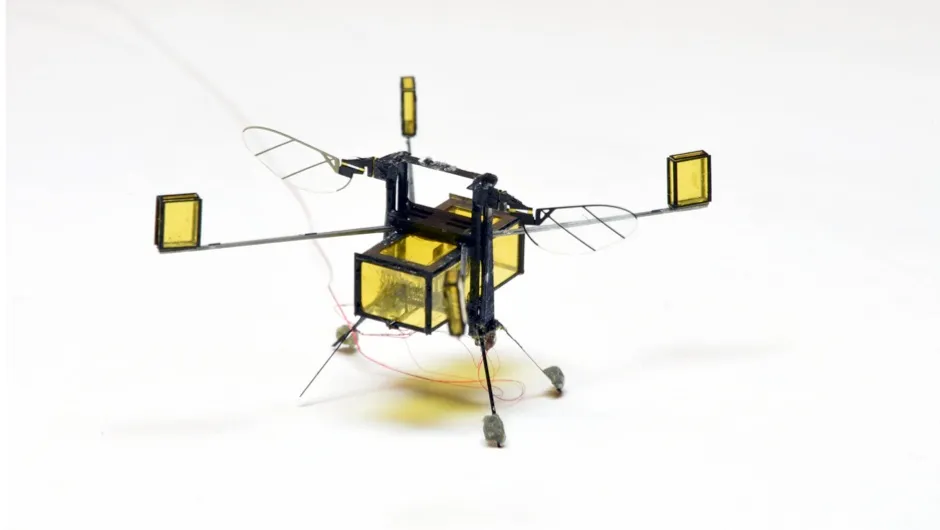If you've ever flown a drone, chances are you've probably crashed a drone, hopefully onto a soft grassy surface. Drones are example of machines whose flying speed has grown faster than their ability to take a hit. Right now, there are around 2.5 million drones flying in the US, according to the Federal Aviation Administration, a number that will triple by 2020. Some drones will be taking wedding photos, others carrying packages. To make these drones more robust, a number of roboticists are looking to nature.
Due to the laws of physics, small objects can more easily survive impacts. You might have seen babies fall on their faces, and get up, laugh, and walk away. This is due to the decreased gravitational and inertial forces that a baby has relative to an adult. Insects are even smaller, so they take this basic concept to perform miraculous feats. Take a mosquito in a rainstorm. A raindrop weighs 50 times as much as a mosquito, but the mosquito uses this to its advantage. When raindrops strike your hand they splash, generating large forces. But a mosquito is so light that raindrops that strike it don't splash. The raindrop simply pushes the mosquito along for the ride, and both experience lower forces.
In the world of the small, strategies for getting around are often quite counter-intuitive. This is an especially important lesson for the future of robotics. The computer age saw the shrinking of electronic devices, and now, in the 3D-printing age, we are seeing the shrinking of all sorts of moving devices, drones, robotic snakes and fish, that are designed to travel in the gusty, leafy, muddy world around us. For years, roboticists have designed robots to avoid touching the world around them. But now that robots are beginning to venture outside.
If you were to look for the most crash-worthy animal, you wouldn't have to look much farther than your garden. The honeybee spends its days gathering pollen and nectar to feed itself and its hungry brood. The faster the brood feeds, the faster it grows. Thus, bees feel a sense of urgency, and every trip out of the hive is a mad dash for food. A bee will gather 30 per cent of its weight in pollen on every trip. On its way back to the hive, it faces a field of moving flower stems, and instead of carefully avoiding them, it often crashes into them at full speed. Over a lifetime it can endure 700,000 crashes, as discovered through microphones that heard these crashes in fields of flowers.

The most vulnerable area of the bee is its paper-thin wings, which weigh as much as a single sesame seed. When the wing is struck against an object, crumple zones allow it to fold like origami, and then to pop back into their original configuration. These designs are beginning to inform new designs for drones. Instead of having the shape of a bee's wing, they use the principles found in the bees: series of springs to absorb energy, and also detachable magnetic parts that can disengage to further dissipate energy.
Roboticists are learning not just from animals in the sky but also those beneath the ankles. The average cockroach must scurry away from predators as quickly as it can. It can even cram its entire body into tunnels that are the height of a stack of two pennies, only one fourth the height of the roach. A cockroach entering this tunnel is like a golden retriever cramming its entire body into a mailbox.
Like the bee, the cockroach has elastic parts of its body. While a cockroach appears to be covered in shiny armor, it has a number of soft joints that permit its body to be surprisingly flexible. For instance, each joint of its legs is composed of a flexible semi- transparent membrane, just like the overlapping lamellae on the knees and shoulders of a medieval knight's body armor. The belly of the cockroach is also covered in overlapping plates like venetian blinds. The cockroach is like a motorized water stress ball, able to keep walking, even while it is squashed unrecognizably flat.
While this work might inspire nightmares, it is giving roboticists idea on how to make robots traverse across rugged terrain. Such robots have applications in search-and-rescue operations, the collapsed rubble of buildings, where the more collapsible the device, the higher chance it can get through to find a victim. Basing their design on a cockroach, roboticists have built a crushable robot named CRAM made of paperboard and two small motors. The robot can crawl into a tunnel half its height and still push its way through, by walking on its knees. Such cheap robots are imagined to be scattered in a rubble site, with simple cameras and transmitters, to scour the area.
David Hu is the author of How to Walk on Water and Climb up Walls: Animal Movement and the Robots of the Future (£20,Princeton University Press)
Follow Science Focus onTwitter,Facebook, Instagramand Flipboard
